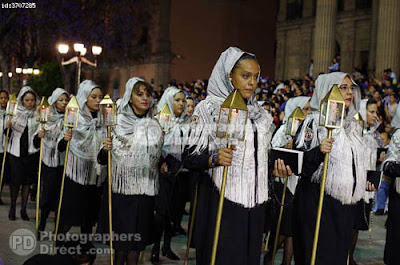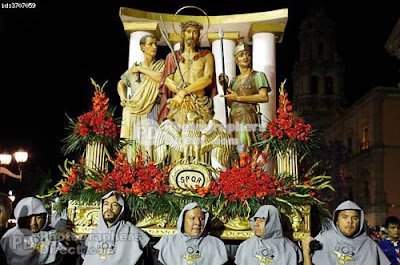 |
Photographer George Olney has sent us some powerful images from this year's Procession of Silence (Procesión Del Silencio Potosina) held annually every Good Friday in San Luis Potosi, Mexico.
The procession follows the journey Jesus Christ is believed to have made on the day of his crucifixion, from being condemned to death, to carrying his cross to Mount Calvary, to being crucified, taken down, and laid in his tomb. It is a centuries-old Christian tradition that is re-enacted across the World during Lent, but not usually so atmospherically or on such a grand scale as at San Luis Potosi.
In San Luis Potosi this symbolic journey between each Station of the Cross (as they are known in Western Christian tradition) covers 5 kilometres of city streets in the historic centre of the city. George Olney tells us: "I counted on the map today, and the procession covers 24 city blocks. You should imagine city blocks like in European cities, not US or Canadian." Painting the scene, he says "Many people do not realize that in the time of the Spanish silver and gold mine occupation, and the revolution, San Luis Potosi was one of Mexico greatest cities, so its Centro Histórico area is quite Spanish."
The original concept of creating halting-places representative of Jesus' journey through Jerusalem to his crucifixion seems to have originated with the Franciscan brotherhood. They had been granted custodianship of holy sites in Palestine in the fourteenth century, and during the fifteenth and sixteenth century they had begun to create outdoor shrines in Europe to duplicate the originals.
But it seems to be another holy order, the Carmelites or Brothers of the Blessed Virgin Mary of Mount Carmel, who brought the tradition to Mexico. George again: "My understanding is that some time around 1600, the Padres Carmelitas brought the tradition to Mexico. I can verify that the Carmelite branch here in San Luis is very active in the event. Then again it depends on whom you talk to. Religion seems to have its own conflicting histories."
George tells us that "the event is put on by Cofradias, which translates directly to Brotherhoods. These are local community churches, that each present their unique interpretations of the 14 stations of the cross. For example, Cofradia Carmelitana presents its interpretation of the Jesus muere en la Cruz Christ dead/dying on the cross. This Cofradia has coffee coloured robes, with white 'Capuchas' - the traditional pointed cone hats." I learn this whilst co-coincidently sipping a cappuccino coffee, and am reminded that cappuccino is derived from the Latin version of a little capucha by way of the colour of the hoods worn by certain Franciscan monks.
But I digress. Can you tell us George when the procession in San Luis Potosi was established? "The exact first procession date varies, but legally, the Public Service Corporation, A.C. in Mexican law, was started in 1966. This is the date I use, and the Traditions Committee uses. However, there was a small Procession published in the paper in 1954."
The procession is decades old then, rather than centuries. But my lasting impressions from Geroge's photos is of how mediaeval it looks. It is following the beat of a drum that has led the religious faithful in Western Europe and, by trade and conquest, Meso- and South America, since the earliest days of Christianity.
Today it is a big event that attracts numerous visitors from across Mexico and beyond, and involves the whole city. George tells us "As an extranjero (foreigner) I am always shocked as to how all the one million residents of San Luis Potosi seem to end up at the Procession! Banks are closed, stores are closed, all taxis are heading down town. It starts at 8 pm, but many families make a day of it."
What is unique about the Procession of Silence, aside from its scale, is that it is held in total silence by the participants and the spectators. It is a sombre, religious event. They are taking part in someone's last hours before a dreadfully painful and long-drawn out death. Someone the faithful believe died to save the whole of humanity.
George Olney describes the silence: "All cell phones are turned off by law. If one did ring, I think the owner would be stoned to death. I have never heard one go off. The only sound is the beating of the drums to keep the pace, and the bugles to announce entry of one of the Cofradia. Rather gives one the chills first time you attend."
I feel a chill myself looking into George's photos of the procession. His images are haunting in their timelessness, in the palpable aura of mystery and deeply held belief. It makes me want to take part in the parade in 2017, though I am not Roman Catholic and can speak only the most meagre of Spanish. I know it is just a dream, but I can content myself at least by viewing the event by proxy of George's lens. And at least I don't need to turn my mobile phone off whilst doing it.
All images are copyright © George Olney. Publishers interested in using these images can contact George by clicking on any of the links below and using the enquiry form on the Photographers Direct website.









